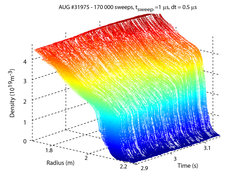Highlights 2015
Research news from the division Plasma Edge and Wall

Leading the discussion: Participants of 15th international workshop on H-mode physics and transport barriers.
Photo: IPP

Density fall-off length in the SOL as a function of the effective collisionality in the divertor.
Figure: IPP

Evolution of the density profile during the L-H transition, measured with an ultrafast microwave reflectometer.
Figure: IPP

Cross section of ITER. The local nitrogen density distribution is colour coded. Dark colours correspond to high nitrogen densities. High nitrogen densities occur in areas of high beryllium deposition.
Graph: IPP
GLADIS: Quality assessment of the W7-X divertor successfully completed

The image shows a W7-X target during high heat flux loading with 10 MW/m² in GLADIS. The spotted glow of the surface at about 1000 °C is caused by the fibre structure of the CFC material.
Figure: IPP

Image: IPP

Figure: IPP

The three new Eurofusion fellows: Matthias Willensdorfer, Mike Dunne and Gergely Papp.
Image: IPP







